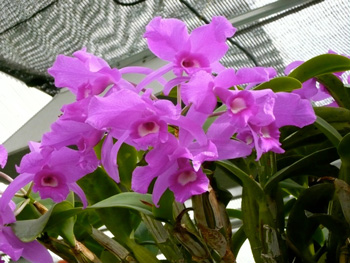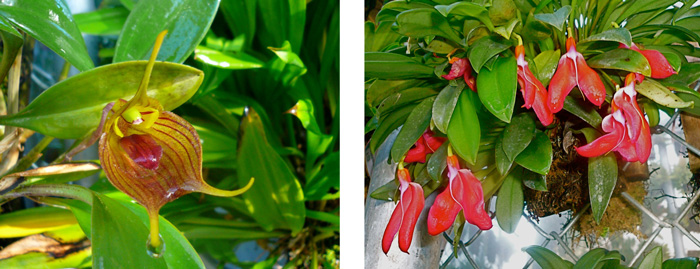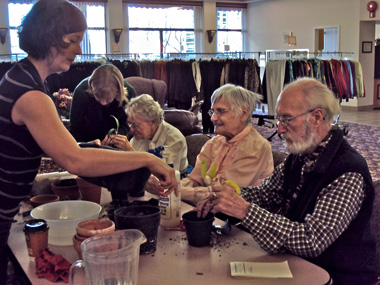An Orchid Oasis
The greenhouse doors slide open, and I am welcomed by a beautiful display of colour, earthy aromas, and high humidity. I close my eyes and momentarily imagine being immersed in the mist-laden ecosystems of Central America.
“This is the first of our three temperature-controlled areas in the greenhouse,†mentions Tandie McCloud, a staff member with the Orchid Species Preservation Foundation. Her voice interrupts my tropical reverie and reminds me I am in Edmonton, Alberta, on a cold, dreary, mid-February afternoon. Longing to escape the characteristic chill of an Alberta winter, I am visiting Edmonton’s iconic Muttart Conservatory for a much-needed glimpse of spring foliage. I am also here to learn first-hand about the Orchid Species Preservation Foundation, a community of orchid enthusiasts dedicated to developing and conserving a world-renown orchid species collection.

“The Foundation dates back to 1991, following the donation of a large personal collection of orchids by the Lorne Stewart family of Vancouver, BC,†notes Doug Bovee, president of the Foundation and a member since the group’s inaugural year. Due to the sheer number of orchid species, the Muttart Conservatory was the only facility in Western Canada able to take in the collection as a whole. The desire to preserve the diverse array of orchids was the impetus of the Foundation, and local orchid growers were keen to work in partnership with the Conservatory.
As we tour through the fragrant greenhouse, I am in awe of the variety of colours, shapes and sizes of these unique specimens. In their natural surroundings, several species of orchids are epiphytes, growing above the ground and deriving their nutrients from the air and precipitation. In the controlled environment of the greenhouse, these epiphytes, suspended above ground level on tiny individual planks, thrive on high humidity and are grown in very little medium. “The roots just drink it all in,†explains Tandie.
Built over a number of years and completed in 2004, the state-of-the-art greenhouse has a total of 5000 square ft. of growing space. Of this space, 2600 square ft. are devoted to the warm and humid section, 1200 square ft. to the intermediate section and 1200 ft. to the cool section. Since orchid species are found on every continent except the Arctic poles, the various temperature settings are essential to create growing conditions similar to the natural environment. Several species in the collection are rare or endangered; therefore, special care is taken to ensure ideal growing conditions are established and maintained. Advanced mechanical and electrical devices are computer controlled to monitor the growing conditions, and a misting system maintains the necessary moisture levels for optimum growth.
 Since 1991, the Orchid Species Preservation Foundation has been involved in a variety of conservation, education and community-based projects. A significant aspect of the education component focuses on hosting programs and courses on how to care for orchids, as well as recruiting volunteers to facilitate these courses. The Foundation also works with schools to incorporate special projects into the curriculum. Doug elaborates upon a recent initiative, where the Foundation brought in a high school class and taught them about orchid care and conservation. Following the program, the Foundation donated a number of plants and the school was paired with a seniors complex. The students visited the centre and built a growing stand for the orchids, and worked alongside the elderly residents to assist with re-potting the plants and establishing them in their growing medium.
Since 1991, the Orchid Species Preservation Foundation has been involved in a variety of conservation, education and community-based projects. A significant aspect of the education component focuses on hosting programs and courses on how to care for orchids, as well as recruiting volunteers to facilitate these courses. The Foundation also works with schools to incorporate special projects into the curriculum. Doug elaborates upon a recent initiative, where the Foundation brought in a high school class and taught them about orchid care and conservation. Following the program, the Foundation donated a number of plants and the school was paired with a seniors complex. The students visited the centre and built a growing stand for the orchids, and worked alongside the elderly residents to assist with re-potting the plants and establishing them in their growing medium.
The successful program is now being used as a prototype for future relationships with other organizations within the community. “We are looking at various avenues for spreading knowledge about orchids and orchid conservation – as well as providing a benefit to the community through connections between youths and seniors,†explains Doug. Orchid care is a topic of conversation relevant to all ages, and sharing these familiar experiences is a valuable way of bridging the generational gap. “Many of the members of the orchid community are elderly, and enjoy acting as ambassadors for sharing their knowledge with the younger generation. Young people are often struggling to establish an identity, and it’s empowering for them to have specialized knowledge,†comments Tandie, who coordinated the project.

We enter the cool section, and I notice a distinct change in temperature from the warm and intermediate areas. These specimens are flourishing under the optimum growth conditions of the greenhouse; however, several species in the Muttart`s collection have an endangered or threatened designation in their natural environment. One of the main reasons for the worldwide decline in orchid numbers is due to habitat loss through human activities such as deforestation and population expansion.
Doug and Tandie explain how the survival of orchids in their natural habitat acts as a flagship to determine the overall health of the ecosystem. Orchids have a symbiotic, or mutually beneficial relationship with a number of species such as pollinators and fungus. Therefore, a healthy population of orchids in a particular environment is an indication that many other plants, animals, insects and microbes are still present. The absence of orchids is a red flag, demonstrating that the entire ecosystem is threatened. In Alberta, 16 of the 26 native orchid species are protected in the Wagner Natural Area, a flora and fauna-rich peatland containing ideal wetland habitat.
As our visit nears a close, I inquire about the organization’s plans and initiatives for the future. Doug enthusiastically mentions an important upcoming event - the twentieth anniversary of the Foundation will be celebrated in October. The three week gala will be a significant milestone for Alberta’s orchid community and the conservation of orchid species. The Foundation also hopes to expand upon their existing repertoire of education programs, build their membership and volunteer base, and establish containers of native orchid species.
I reluctantly leave the beautiful greenhouse oasis and venture into the frosty, snow-covered February landscape. I will return to the Conservatory in the future; but for now, I will hold on to the image of the exquisite orchid collection as a reminder that spring is just around the corner.
The Orchid Species Preservation Foundation: www.orchidspecies.ca
Photo credits: Doug Bovee

